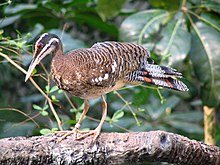Eurypygiformes
| Eurypygiformes | |
|---|---|

| |

| |
| Scientific classification | |
| Domain: | Eukaryota |
| Kingdom: | Animalia |
| Phylum: | Chordata |
| Class: | Aves |
| Clade: | Eurypygimorphae |
| Order: | Eurypygiformes Hackett et al., 2008 |
| Families | |
| |
Eurypygiformes Rhynochetidae endemic to New Caledonia, and the sunbittern (Eurypyga helias) from the tropical regions of the Americas.[1] Its closest relatives appear to be the tropicbirds of the tropical Atlantic, Indian, and Pacific oceans.[2]
Classification
The affinities of Eurypygiformes are not very well resolved. The group consists of two families from a
Ardeidae, and later the Gruiformes. According to Jarvis, et al.'s 2014 "Whole-genome analyses resolve early branches in the tree of life of modern birds", the group is distantly related to the Phaethontiformes.[2]
When seen as a gruiform, the flamingos). The usefulness and monophyly of "Metaves" is therefore unclear. Notwithstanding, the kagu and sunbittern – and possibly the adzebills – seem to form a distinct Gondwanan lineage of birds, possibly one order, possibly more, even though the relationships between them, the mesites, and the "core Gruiformes" are not yet resolved. It is notable, however, that the sunbittern and the mesites possess powder down
, whereas the "core Gruiformes" do not.
While the
Rhynochetos jubatus, with no overlap in measurements except those of the wings. Given that the sites where R. orarius has been found are all lowland sites, and that no fossils of R. jubatus were found in these sites, the scientists who described the fossils suggested they represented highland and lowland species, respectively. R. orarius is one of many species to have become extinct in New Caledonia after the arrival of humans.[5] The validity of the species has been questioned by some authors,[6] but accepted by others.[7]
Fossil Messelornithidae once included in Eurypygiformes are now considered the oldest known members of Ralloidea (Gruiformes).[8][9]
Species by global population
| Common name | Binomial name
|
Population | Status | Trend | Notes | Image |
|---|---|---|---|---|---|---|
| Kagu | Rhynochetos jubatus | 601-2,000[10] | EN[10] | Equal to 250-999 mature individuals.[10] | 
| |
| Sunbittern | Eurypyga helias | 500,000-4,999,999[11] | LC[11] | Estimate for mature individuals only.[11] | 
|
References
- S2CID 6472805. Retrieved 2008-10-18.
- ^ S2CID 52818555.
- S2CID 1296408. Archived from the original(PDF) on 2012-07-19. Retrieved 2012-04-28.
- PMID 26624624.
- .
- ISBN 84-87334-20-2
- ISBN 978-0-226-77142-7.
- S2CID 202849094.
- hdl:2440/119533.
- ^ .
- ^ .
